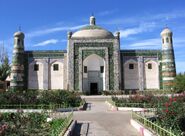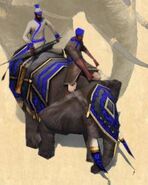Nikitazero (talk | contribs) m (→Upgrades) |
(→Technologies: untrue fishing boats have the villager tag) |
||
| (12 intermediate revisions by 3 users not shown) | |||
| Line 1: | Line 1: | ||
| − | {{Infobox |
+ | {{Infobox civilization |
| − | | |
+ | |Name = Sufi Mosque |
| − | | |
+ | |Image = Sufi_Icon.png |
| − | | |
+ | |Caption = The Sufi Mosque Trading Post icon |
| − | | |
+ | |Intro = {{AoE3Icon|TAD}} ''[[Age of Empires III: The Asian Dynasties|The Asian Dynasties]]'' |
| − | | |
+ | |Continent = Asia |
| − | | |
+ | |Unit = [[File:War Elephant.png|22px]] [[War Elephant (Age of Empires III)|War Elephant]] |
| − | | |
+ | |Tech = [[File:Pilgrimage.png|22px]] [[Pilgrimage]]<br/>[[File:Fasting.png|22px]] [[Fasting]]<br/>[[File:Sharia.png|22px]] [[Sharia]] |
| − | | |
+ | |Map = [[Borneo]]<br/>[[Deccan]]<br/>[[Indochina]]<br/>[[Mongolia]]<br/>[[Silk Road (map)|Silk Road]] |
| + | |Native = 1 |
||
| ⚫ | |||
| ⚫ | |||
| − | |||
| ⚫ | |||
| − | The Sufi Mosque is available on the [[Borneo]], [[Deccan]], [[Indochina]], [[Mongolia]], and [[Silk Road (map)|Silk Road]] maps. |
||
== Unit == |
== Unit == |
||
| + | :[[File:War Elephant.png|22px]] [[War Elephant (Age of Empires III)|War Elephant]]: [[Indians (Age of Empires III)|Indian]] Heavy War Elephant powerful in close combat. Inflicts area damage. Good against [[archers]] and [[skirmisher]]s. |
||
| − | {| class="article-table" border="1" cellpadding="1" cellspacing="1" |
||
| − | ! scope="col" |Icon |
||
| − | ! scope="col" |Unit |
||
| − | ! scope="col" |Description |
||
| − | |- |
||
| − | |[[File:War Elephant.png|64px|center]] |
||
| − | |[[War Elephant (Age of Empires III)|War Elephant]] |
||
| − | |Indian elephant cavalry that deals [[Area of Effect|splash damage]], good against archers and Skirmishers; limited to 6 for each Sufi settlement |
||
| ⚫ | |||
| − | == |
+ | == Technologies == |
| + | {| class="wikitable" |
||
| − | {| border="1" cellspacing="2" cellpadding="3" class="article-table" |
||
| − | ! |
+ | ! style="width: 5%;" |[[Age]] |
| − | ! |
+ | ! style="width: 25%;" |Technology |
| − | ! |
+ | ! style="width: 10%;" |Cost |
| − | ! |
+ | ! style="width: 60%;" |Effect |
| − | ! scope="col" |Effect |
||
|- |
|- |
||
| + | | rowspan=3 |{{AoE3Age|1|C}} |
||
| − | |[[File:ages discovery.jpg|link=Discovery Age|center]] |
||
| − | |[[File:Pilgrimage.png| |
+ | |[[File:Pilgrimage.png|22px]] [[Pilgrimage]] |
| ⚫ | |||
| − | |Pilgrimage |
||
| ⚫ | |||
| ⚫ | |||
| ⚫ | |||
|- |
|- |
||
| − | |[[File: |
+ | |[[File:Fasting.png|22px]] [[Fasting]] |
| ⚫ | |||
| − | |[[File:Fasting.png|center]] |
||
| + | |[[Villager#Age of Empires III|Villager]] (and [[Fishing Boat (Age of Empires III)|Fishing Boats]]) get -40% [[hit points]] but [[Settler]]s, [[Coureur des Bois|Coureurs des Bois]], [[Settler Wagon]]s, and [[Villager (Age of Empires III)|Villagers]] gather 10% faster. |
||
| − | |Fasting |
||
| ⚫ | |||
| − | |[[Settler]]s/[[Villager (Age of Empires III)|Villager]]s get -40% health but gather resources 10% faster |
||
|- |
|- |
||
| − | |[[File: |
+ | |[[File:Sharia.png|22px]] [[Sharia]] |
| ⚫ | |||
| − | |[[File:Sharia.png|center]] |
||
| ⚫ | |||
| − | |Sharia |
||
| ⚫ | |||
| ⚫ | |||
| − | |- |
||
| − | |[[File:ages fortress.jpg|link=Fortress Age|center]] |
||
| − | |[[File:Disciplined_natives.png|center]] |
||
| − | |Sufi Discipline Training |
||
| − | |{{resources|wood=200|coin=150}} |
||
| − | |Upgrades War Elephants to Disciplined (+20% hit points and attack) |
||
| − | |- |
||
| − | |[[File:ages industrial.jpg|link=Industrial Age|center]] |
||
| − | |[[File:Honered_natives.png|center]] |
||
| − | |Sufi Honor Training |
||
| − | |{{resources|wood=400|coin=300}} |
||
| − | |Upgrades War Elephants to Honored (+30% hit points and attack); requires Sufi Honor Training |
||
|} |
|} |
||
| − | + | == Trivia == |
|
| ⚫ | |||
| − | * Sharia works well for the [[Dutch]], the [[French]] and the [[Japanese (Age of Empires III)|Japanese]] due to their lower villager limits. |
||
| ⚫ | |||
| − | * Note that with Fasting, Settlers/Villagers are quickly killed if attacked, making them more vulnerable and should be kept safe. |
||
== History == |
== History == |
||
{{quote|This Holy Site is identical to a Native Trade Site. Allying with Natives allows a player to train special Native units, usually warriors, and also grants access to a group of improvements to that tribe. Native units do not cost any population spaces, but can only be built in limited numbers.<br/><br/>The word “sufi” first appeared in the 8th century and is considered to be a reference to the coarse wool garments worn by spiritual men who sought lives of spiritual harmony, free from bodily pleasure and in harmony with nature. The word “sufism” was first used in the 9th century, and became a blanket term for a variety of different forms of Islamic mysticism incorporating such disparate elements as Christian monasticism, gnosticism, and Indian mysticism.<br/><br/>Because Sufism encompasses a number of belief systems, its origins can be linked to a wide range of geographic regions and periods. However, many consider Sufism to have begun with the practice of Shiite Muslims in the 7th century in what is now Iraq, although others claim that Sufism predates Islam and simply used the other religion as a vehicle for its teachings.<br/><br/>Throughout its long history, Sufism has been criticized for its mystical elements. While it has made significant contributions to the spread of Islam and the development of Islamic culture, conservative Muslims still disagree with its abundance of non-Islamic customs.}} |
{{quote|This Holy Site is identical to a Native Trade Site. Allying with Natives allows a player to train special Native units, usually warriors, and also grants access to a group of improvements to that tribe. Native units do not cost any population spaces, but can only be built in limited numbers.<br/><br/>The word “sufi” first appeared in the 8th century and is considered to be a reference to the coarse wool garments worn by spiritual men who sought lives of spiritual harmony, free from bodily pleasure and in harmony with nature. The word “sufism” was first used in the 9th century, and became a blanket term for a variety of different forms of Islamic mysticism incorporating such disparate elements as Christian monasticism, gnosticism, and Indian mysticism.<br/><br/>Because Sufism encompasses a number of belief systems, its origins can be linked to a wide range of geographic regions and periods. However, many consider Sufism to have begun with the practice of Shiite Muslims in the 7th century in what is now Iraq, although others claim that Sufism predates Islam and simply used the other religion as a vehicle for its teachings.<br/><br/>Throughout its long history, Sufism has been criticized for its mystical elements. While it has made significant contributions to the spread of Islam and the development of Islamic culture, conservative Muslims still disagree with its abundance of non-Islamic customs.}} |
||
| − | |||
| − | == Trivia == |
||
| ⚫ | |||
| ⚫ | |||
== Gallery == |
== Gallery == |
||
| Line 79: | Line 49: | ||
War_elephant_age_of_empires_3.jpg|A War Elephant |
War_elephant_age_of_empires_3.jpg|A War Elephant |
||
</gallery> |
</gallery> |
||
| + | {{-}} |
||
| − | |||
{{Civilizations (AoE3)}} |
{{Civilizations (AoE3)}} |
||
[[Category:Age of Empires III]] |
[[Category:Age of Empires III]] |
||
Revision as of 22:23, 20 March 2020
The Sufi Mosque is a native Asian religious settlement featured in Age of Empires III: The Asian Dynasties. Like all natives, they can be allied with by building a Trading Post at their Trading Post site.
Unit
 War Elephant: Indian Heavy War Elephant powerful in close combat. Inflicts area damage. Good against archers and skirmishers.
War Elephant: Indian Heavy War Elephant powerful in close combat. Inflicts area damage. Good against archers and skirmishers.
Technologies
| Age | Technology | Cost | Effect |
|---|---|---|---|
| 250 food 250 coin |
Ships 1 Fattened Goat for every 2 minutes the game has passed, up to 30 minutes | ||
| 200 wood 200 coin |
Villager (and Fishing Boats) get -40% hit points but Settlers, Coureurs des Bois, Settler Wagons, and Villagers gather 10% faster. | ||
| 100 food 100 coin |
Villager train limit +10% |
Trivia
- The Sufi Mosque resembles the Shrine of Ali mosque and overall it appears to be based on the architecture of Shiite mosques.
- In the Sufi Mosque an elderly figure which looks similar to the Brahmin can be seen, although there is no correlation between them.
History
| “ | This Holy Site is identical to a Native Trade Site. Allying with Natives allows a player to train special Native units, usually warriors, and also grants access to a group of improvements to that tribe. Native units do not cost any population spaces, but can only be built in limited numbers. The word “sufi” first appeared in the 8th century and is considered to be a reference to the coarse wool garments worn by spiritual men who sought lives of spiritual harmony, free from bodily pleasure and in harmony with nature. The word “sufism” was first used in the 9th century, and became a blanket term for a variety of different forms of Islamic mysticism incorporating such disparate elements as Christian monasticism, gnosticism, and Indian mysticism. Because Sufism encompasses a number of belief systems, its origins can be linked to a wide range of geographic regions and periods. However, many consider Sufism to have begun with the practice of Shiite Muslims in the 7th century in what is now Iraq, although others claim that Sufism predates Islam and simply used the other religion as a vehicle for its teachings. Throughout its long history, Sufism has been criticized for its mystical elements. While it has made significant contributions to the spread of Islam and the development of Islamic culture, conservative Muslims still disagree with its abundance of non-Islamic customs. | ” |
Gallery
A Sufi settlement
Template:Civilizations (AoE3)


